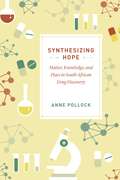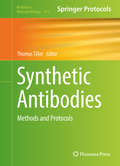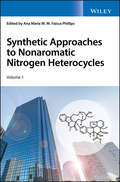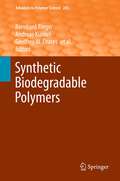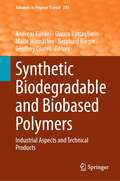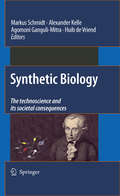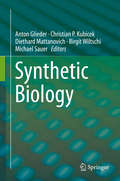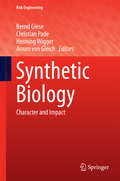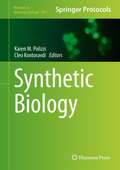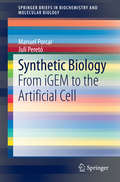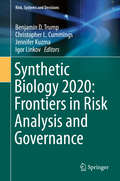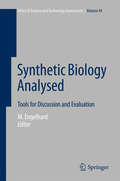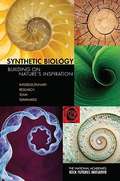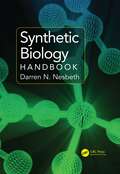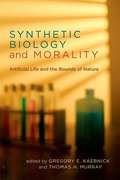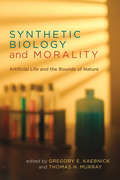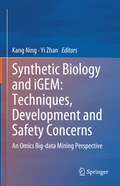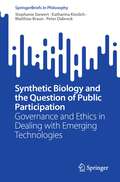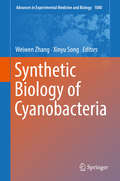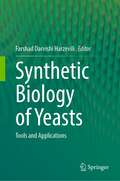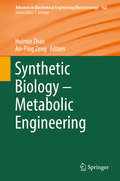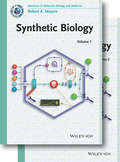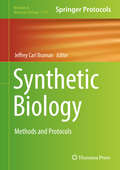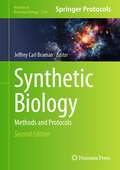- Table View
- List View
Synthesizing Hope: Matter, Knowledge, and Place in South African Drug Discovery
by Anne PollockSynthesizing Hope opens up the material and social world of pharmaceuticals by focusing on an unexpected place: iThemba Pharmaceuticals. Founded in 2009 with a name taken from the Zulu word for hope, the small South African startup with an elite international scientific board was tasked with drug discovery for tuberculosis, HIV, and malaria. Anne Pollock uses this company as an entry point for exploring how the location of scientific knowledge production matters, not only for the raw materials, manufacture, licensing, and distribution of pharmaceuticals but also for the making of basic scientific knowledge. Consideration of this case exposes the limitations of global health frameworks that implicitly posit rich countries as the only sites of knowledge production. Analysis of iThemba identifies the problems inherent in global north/south divides at the same time as it highlights what is at stake in who makes knowledge and where. It also provides a concrete example for consideration of the contexts and practices of postcolonial science, its constraints, and its promise. Synthesizing Hope explores the many legacies that create conditions of possibility for South African drug discovery, especially the specific form of settler colonialism characterized by apartheid and resource extraction. Paying attention to the infrastructures and laboratory processes of drug discovery underscores the materiality of pharmaceuticals from the perspective of their makers, and tracing the intellectual and material infrastructures of South African drug discovery contributes new insights about larger social, political, and economic orders.
Synthetic Antibodies
by Thomas TillerThis detailed volume presents a set of protocols useful for researchers in the field of recombinant immunoglobulin and alternative scaffold engineering, aptamer development, and generation of molecularly imprinted polymers (MIPs). Part I includes methods that deal with amino-acid based synthetic antibodies. Brief protocols about the generation of antibody libraries are detailed, as well as techniques for antibody selection, characterization, and validation. This section is completed by a brief description of a bioinformatics platform that supports antibody engineering during research and development. Part II contains basic procedures about the selection and characterization of aptamer molecules, and Part III describes fundamental processes of MIP generation and application. Written for the highly successful Methods in Molecular Biology series, chapters include introductions to their respective topics, lists of the necessary materials and reagents, step-by-step, readily reproducible laboratory protocols, and tips on troubleshooting and avoiding known pitfalls. Authoritative and practical, Synthetic Antibodies: Methods and Protocols is an ideal guide for scientists seeking to propel the vital study of antibody research.
Synthetic Approaches to Nonaromatic Nitrogen Heterocycles
by Ana Maria Faisca PhillipsA comprehensive overview of synthetic strategies for nonaromatic nitrogen heterocycles Nitrogen heterocycles are extremely widely distributed in nature, as well as in synthetic substances found in pharmaceuticals, agrochemicals, and materials chemistry. With new structures and medicines that include these structures emerging yearly, and a vast new journal literature to describe them, anyone who wants to be effective in R&D needs to easily access a synthesis of the latest research. This state-of-the-art survey explores recent developments in the most widely used reactions, as well as completely new ones. Highlights the major modern synthetic methods known to obtain nonaromatic nitrogen heterocycles, and their practical applications Topics include enantioselective synthesis and catalysis, photocatalysis, biocatalysis, microwave-assisted synthesis, reactions of oximes and nitrones, and ionic liquids Discusses how to synthesize rings of specific sizes Covers sustainable synthetic approaches for obtaining salts Whether you are using nonaromatic nitrogen compounds as an academic researcher, a synthetic chemist in industry, or an advanced student, this book is an essential, up-to-date resource to support your work.
Synthetic Biodegradable Polymers
by Bernhard Rieger Andreas Künkel Robert Reichardt Geoffrey W. Coates Eckhard Dinjus Thomas A. ZevacoSalen Metal Complexes as Catalysts for the Synthesis of Polycarbonates from Cyclic Ethers and Carbon Dioxide, by Donald J. Darensbourg.- Material Properties of Poly(Propylene Carbonates), by Gerrit. A. Luinstra and Endres Borchardt.- Poly(3-Hydroxybutyrate) from Carbon Monoxide, by Robert Reichardt and Bernhard Rieger. - Ecoflex® and Ecovio®: Biodegradable, Performance-Enabling Plastics, by K. O. Siegenthaler, A. Künkel, G. Skupin and M. Yamamoto.- Biodegradability of Poly(Vinyl Acetate) and Related Polymers, by Manfred Amann and Oliver Minge.- Recent Developments in Ring-Opening Polymerization of Lactones, by P. Lecomte and C. Jérôme.- Recent Developments in Metal-Catalyzed Ring-Opening Polymerization of Lactides and Glycolides: Preparation of Polylactides, Polyglycolide, and Poly(lactide-co-glycolide), by Saikat Dutta, Wen-Chou Hung, Bor-Hunn Huang and Chu-Chieh Lin.- Bionolle (Polybutylenesuccinate), by Yasushi Ichikawa, Tatsuya Mizukoshi.- Polyurethanes from Renewable Resources, by David A. Babb.-
Synthetic Biodegradable and Biobased Polymers: Industrial Aspects and Technical Products (Advances in Polymer Science #293)
by Bernhard Rieger Andreas Künkel Glauco Battagliarin Malte Winnacker Geoffrey CoatesThis volume presents the recent developments in synthetic biodegradable and biobased polymers. The syntheses of many polymer types such as polyesters and polyamides, and also their processing technologies are discussed herein, and new aspects from fundamental and from industrial research are covered. This combination of both perspectives within this volume will be of interest for many research scientists from academia and industry and also for lectures and teachers. Chapters ''BioPBSTM (Polybutylene succinate)'' and ''Polymer biodegradability 2.0: A holistic view on polymer biodegradation in natural and engineered environments'' are available open access under a Creative Commons Attribution 4.0 International License via link.springer.com. For further details see license information in the chapter.
Synthetic Biology
by Alexander Kelle Markus Schmidt Agomoni Ganguli-Mitra Huib De VriendSynthetic biology is becoming one of the most dynamic new fields of biology, with the potential to revolutionize the way we do biotechnology today. By applying the toolbox of engineering disciplines to biology, a whole set of potential applications become possible ranging very widely across scientific and engineering disciplines. Some of the potential benefits of synthetic biology, such as the development of low-cost drugs or the production of chemicals and energy by engineered bacteria are enormous. There are, however, also potential and perceived risks due to deliberate or accidental damage. Also, ethical issues of synthetic biology just start being explored, with hardly any ethicists specifically focusing on the area of synthetic biology. This book will be the first of its kind focusing particularly on the safety, security and ethical concerns and other relevant societal aspects of this new emerging field. The foreseen impact of this book will be to stimulate a debate on these societal issues at an early stage. Past experiences, especially in the field of GM-crops and stem cells, have shown the importance of an early societal debate. The community and informed stakeholders recognize this need, but up to now discussions are fragmentary. This book will be the first comprehensive overview on relevant societal issues of synthetic biology, setting the scene for further important discussions within the scientific community and with civil society.
Synthetic Biology
by Christian P. Kubicek Anton Glieder Diethard Mattanovich Birgit Wiltschi Michael SauerThis book provides a comprehensive, up-to-date overview of the opportunities and challenges of the complex field of synthetic biology, which combines various scientific disciplines. The emerging field of synthetic biology employs biotechnological approaches to recreate and enhance basic biological structures, intracellular processes and whole organisms. The book addresses a broad range of topics, including redesigning complex metabolic pathways, DNA/RNA and protein engineering, as well as novel synthetic biomaterials. It discusses both "bottom up" and "top down" approaches and presents the latest genome engineering tools with predictions about how these could change our way of thinking and working. Since the use of synthetic biology raises a number of ethical questions, a chapter is devoted to public awareness and risk management. The book is of interest to scientists from both academia and industry, as well as PhD students and postdocs working in the field
Synthetic Biology
by Bernd Giese Christian Pade Henning Wigger Arnim Von GleichSynthetic Biology is already an object of intensive debate. However, to a great extent the discussion to date has been concerned with fundamental ethical, religious and philosophical questions. By contrast, based on an investigation of the field's scientific and technological character, this book focuses on new functionalities provided by synthetic biology and explores the associated opportunities and risks. Following an introduction to the subject and a discussion of the most central paradigms and methodologies, the book provides an overview of the structure of this field of science and technology. It informs the reader about the current stage of development, as well as topical problems and potential opportunities in important fields of application. But not only the science itself is in focus. In order to investigate its broader impact, ecological as well as ethical implications will be considered, paving the way for a discussion of responsibilities in the context of a field at a transitional crossroads between basic and applied science. In closing, the requirements for a suitable regulatory framework are discussed. The book is intended as a source of information and orientation for researchers, students and practitioners in the natural sciences and technology assessment; for members of scientific and technological, governmental and funding institutions; and for members of the general public interested in essential information on the current status, prospects and implications of synthetic biology.
Synthetic Biology
by Karen M. Polizzi Cleo KontoravdiIn Synthetic Biology, expert researchers in the field provide the latest developments in molecular biology techniques used in Synthetic Biology. Focusing on computational tools that will aid in systematising the design and construction of parts and systems. Written in the highly successful Methods in Molecular BiologyTM series format, chapters include introductions to their respective topics, lists of the necessary materials and reagents, step-by-step, readily reproducible laboratory protocols, and key tips on troubleshooting and avoiding known pitfalls. Authoritative and practical, Synthetic Biology seeks to aid scientists in the further study of developing new biological components and systems.
Synthetic Biology
by Manuel Porcar Juli PeretóSynthetic Biology (SB) is a revolutionary discipline with a vast range of practical applications, but is SB research really based on engineering principles? Does it contributing to the artificial synthesis of life or does it utilise approaches sufficiently advanced to fall outside the scope of biotechnology or metabolic engineering? This volume reviews the development of SB and includes the major milestones of the discipline, the 'top-down' and 'bottom-up' approaches towards the construction of an artificial cell and the development of the "iGEM" competition. We conclude that SB is an emerging field with extraordinary technological potential, but that most research projects actually are an extension of metabolic engineering since the complexity of living organisms, their tight dependence on evolution and our limited knowledge of the interactions between the molecules, actually make life difficult to engineer.
Synthetic Biology 2020: Frontiers in Risk Analysis and Governance (Risk, Systems and Decisions)
by Igor Linkov Benjamin D. Trump Christopher L. Cummings Jennifer KuzmaSynthetic biology offers powerful remedies for some of the world’s most intractable problems, but these solutions are clouded by uncertainty and risk that few strategies are available to address. The incentives for continued development of this emerging technology are prodigious and obvious, and the public deserves assurances that all potential downsides are duly considered and minimized accordingly. Incorporating social science analysis within the innovation process may impose constraints, but its simultaneous support in making the end products more acceptable to society at large should be considered a worthy trade-off.Contributing authors in this volume represent diverse perspectives related to synthetic biology’s social sciences, and reflect on different areas of risk analysis and governance that have developed for the field. Such perspectives include leading scholarly discussion pertaining to risk assessment, governance, ethics, and communication. The chapters of this volume note that while the first twenty years of synthetic biology development have focused strongly on technological innovation and product development, the next twenty should emphasize the synergy between developers, policymakers, and publics to generate the most beneficial, well governed, and transparent technologies and products possible. Many chapters in this volume provide new data and approaches that demonstrate the feasibility for multi-stakeholder efforts involving policymakers, regulators, industrial developers, workers, experts, and societal representatives to share responsibilities in the production of effective and acceptable governance in the face of uncertain risk probabilities. A full consideration of such perspectives may prevent a world of draconian regulations based on an insufficient or incomplete understanding of the science that underpins synthetic biology, as well as any hesitancy or fear by the public to adopt its eventual products.
Synthetic Biology Analysed
by Margret EngelhardSynthetic biology is a dynamic, young, ambitious, attractive, and heterogeneous scientific discipline. It is constantly developing and changing, which makes societal evaluation of this emerging new science a challenging task, prone to misunderstandings. Synthetic biology is difficult to capture, and confusion arises not only regarding which part of synthetic biology the discussion is about, but also with respect to the underlying concepts in use. This book offers a useful toolbox to approach this complex and fragmented field. It provides a biological access to the discussion using a 'layer' model that describes the connectivity of synthetic or semisynthetic organisms and cells to the realm of natural organisms derived by evolution. Instead of directly reviewing the field as a whole, firstly our book addresses the characteristic features of synthetic biology that are relevant to the societal discussion. Some of these features apply only to parts of synthetic biology, whereas others are relevant to synthetic biology as a whole. In the next step, these new features are evaluated with respect to the different areas of synthetic biology. Do we have the right words and categories to talk about these new features? In the third step, traditional concepts like "life" and "artificiality" are scrutinized with regard to their discriminatory power. This approach may help to differentiate the discussion on synthetic biology. Lastly our refined view is utilized for societal evaluation. We have investigated the public views and attitudes to synthetic biology. It also includes the analysis of ethical, risk and legal questions, posed by present and future practices of synthetic biology. This book contains the results of an interdisciplinary research project and presents the authors' main findings and recommendations. They are addressed to science, industry, politics and the general public interested in this upcoming field of biotechnology.
Synthetic Biology Building on Nature's Inspiration: Interdisciplinary Research Team Summaries
by The National AcademiesSynthetic biology is an innovative and growing field that unites engineering and biology. It builds on the powerful research that came about as a result of a recombinant DNA technology and genome sequencing. By definition, synthetic biology is an interdisciplinary enterprise comprising biologists of many specialties, engineers, physicists, computer scientists and others. It promises a fundamentally deeper understanding of how living systems work and the capacity to recreate them for medicine, public health and the environment, including renewable energy. NAKFI Synthetic Biology: Building a Nation's Inspiration discusses new foundational technologies and tools required to make biology easier to engineer, considers ethical issues unique to synthetic biology, explores how synthetic biology can lead to an understanding of the principles underlying natural genetic circuits and debates how synthetic biology can be used to answer fundamental biological questions.
Synthetic Biology Handbook
by Darren N. NesbethThe Synthetic Biology Handbook explains the major goals of the field of synthetic biology and presents the technical details of the latest advances made in achieving those goals. Offering a comprehensive overview of the current areas of focus in synthetic biology, this handbook:Explores the standardisation of classic molecular bioscience approaches
Synthetic Biology and Morality: Artificial Life and the Bounds of Nature
by Gregory E. Kaebnick Thomas H. MurraySynthetic biology, which aims to design and build organisms that serve human needs, has potential applications that range from producing biofuels to programming human behavior. The emergence of this new form of biotechnology, however, raises a variety of ethical questions -- first and foremost, whether synthetic biology is intrinsically troubling in moral terms. Is it an egregious example of scientists "playing God"? "Synthetic Biology and Morality" takes on this threshold ethical question, as well as others that follow, offering a range of philosophical and political perspectives on the power of synthetic biology. The contributors consider the basic question of the ethics of making new organisms, with essays that lay out the conceptual terrain and offer opposing views of the intrinsic moral concerns; discuss the possibility that synthetic organisms are inherently valuable; and address whether, and how, moral objections to synthetic biology could be relevant to policy making and political discourse. Variations of these questions have been raised before, in debates over other biotechnologies, but, as this book shows, they take on novel and illuminating form when considered in the context of synthetic biology. ContributorsJohn Basl, Mark A. Bedau, Joachim Boldt, John H. Evans, Bruce Jennings, Gregory E. Kaebnick, Ben Larson, Andrew Lustig, Jon Mandle, Thomas H. Murray, Christopher J. Preston, Ronald Sandler
Synthetic Biology and Morality: Artificial Life and the Bounds of Nature (Basic Bioethics)
by Gregory E. Kaebnick Thomas H. MurrayA range of views on the morality of synthetic biology and its place in public policy and political discourse.Synthetic biology, which aims to design and build organisms that serve human needs, has potential applications that range from producing biofuels to programming human behavior. The emergence of this new form of biotechnology, however, raises a variety of ethical questions—first and foremost, whether synthetic biology is intrinsically troubling in moral terms. Is it an egregious example of scientists “playing God”? Synthetic Biology and Morality takes on this threshold ethical question, as well as others that follow, offering a range of philosophical and political perspectives on the power of synthetic biology.The contributors consider the basic question of the ethics of making new organisms, with essays that lay out the conceptual terrain and offer opposing views of the intrinsic moral concerns; discuss the possibility that synthetic organisms are inherently valuable; and address whether, and how, moral objections to synthetic biology could be relevant to policy making and political discourse. Variations of these questions have been raised before, in debates over other biotechnologies, but, as this book shows, they take on novel and illuminating form when considered in the context of synthetic biology.ContributorsJohn Basl, Mark A. Bedau, Joachim Boldt, John H. Evans, Bruce Jennings, Gregory E. Kaebnick, Ben Larson, Andrew Lustig, Jon Mandle, Thomas H. Murray, Christopher J. Preston, Ronald Sandler
Synthetic Biology and iGEM: An Omics Big-data Mining Perspective
by Kang Ning Yi ZhanThis book focuses on biological engineering techniques, multi-omics big-data integration, and data-mining techniques, as well as cutting-edge researches in principles and applications of several synthetic biology applications. Synthetic biology is a new research area, while it has been rooted from the long-established area including biological engineering, metabolite engineering, and systems biology. This book will discuss the following aspects: (1) introduction to synthetic biology and iGEM, especially focusing on the systematic design, rational engineering, and sustainability of design in the omics ages; (2) synthetic biology–related multi-omics data integration and data mining techniques; (3) the technical issues, development issues, and safety issues of synthetic biology; (4) data resources, web services, and visualizations for synthetic biology; and (5) advancement in concrete research on synthetic biology, with several case studies shown. Devised as a book on synthetic biology research and education in the omics age, this book has put focuses on systematic design, rational engineering, and sustainability of design for synthetic biology, which will explain in detail and with supportive examples the “What,” “Why,” and “How” of the topic. It is an attempt to bridge the gap between synthetic biology’s research and education side, for best practice of synthetic biology and in-depth insights for the related questions.
Synthetic Biology and the Question of Public Participation: Governance and Ethics in Dealing with Emerging Technologies (SpringerBriefs in Philosophy)
by Matthias Braun Peter Dabrock Stephanie Siewert Katharina KieslichThe book considers the relationship between governance and participation, and the ways participation has been understood, framed and applied in the context of synthetic biology (SB) governance approaches. Based on fundamental questions about the scope, purpose, and responsibilities assigned to public participation activities, the authors conducted an literature review of policy reports and articles on SB governance. The authors identify key characteristics of synthetic biology, such as the complex interplay of research, engineering and IT expertise in the field, as well as the challenges these characteristics pose in designing governance frameworks. Drawing on insights from a literature review, the authors contest calls for “earlier” and “more” participation on the basis that such calls fail to consider the necessary structural adjustments and resources needed for such endeavors. The brief addresses ethical questions arising in synthetic biology that could be used for developing frameworks of governance in the ongoing COVID-19 crisis and the consequent innovations in vaccine research.
Synthetic Biology of Cyanobacteria (Advances in Experimental Medicine and Biology #1080)
by Weiwen Zhang Xinyu SongThis volume highlights recent breakthroughs in the interdisciplinary areas of synthetic biology, metabolic engineering and bioprocess engineering for the production of green chemicals. It also presents practical experimental and computational tools for the design, construction and manipulation of cyanobacteria cell factories. The respective contributions cover new technologies in the field, such as novel genetic transformation techniques and bioinformatics analysis methods and address various aspects of cyanobacterial synthetic biology, offering a valuable resource for students and researchers in the fields of industry microbiology and biomedical engineering.
Synthetic Biology of Yeasts: Tools and Applications
by Farshad Darvishi HarzeviliThis book covers recent advances and future trends in yeast synthetic biology, providing readers with an overview of computational and engineering tools, and giving insight on important applications. Yeasts are one of the most attractive microbial cell factories for the production of a wide range of valuable products, including pharmaceuticals, nutraceuticals, cosmetics, agrochemicals and biofuels. Synthetic biology tools have been developed to improve the metabolic engineering of yeasts in a faster and more reliable manner. Today, these tools are used to make synthetic pathways and rewiring metabolism even more efficient, producing products at high titer, rate, and yield. Split into two parts, the book opens with an introduction to rational metabolic pathway prediction and design using computational tools and their applications for yeast systems and synthetic biology. Then, it focuses on the construction and assembly of standardized biobricks for synthetic pathway engineering in yeasts, yeast cell engineering and whole cell yeast-based biosensors. The second part covers applications of synthetic biology to produce diverse and attractive products by some well-known yeasts. Given its interdisciplinary scope, the book offers a valuable asset for students, researchers and engineers working in biotechnology, applied microbiology, metabolic engineer ing and synthetic biology.
Synthetic Biology – Metabolic Engineering
by An-Ping Zeng Huimin ZhaoThis book review series presents current trends in modern biotechnology. The aim is to cover all aspects of this interdisciplinary technology where knowledge, methods and expertise are required from chemistry, biochemistry, microbiology, genetics, chemical engineering and computer science. Volumes are organized topically and provide a comprehensive discussion of developments in the respective field over the past 3-5 years. The series also discusses new discoveries and applications. Special volumes are dedicated to selected topics which focus on new biotechnological products and new processes for their synthesis and purification. In general, special volumes are edited by well-known guest editors. The series editor and publisher will however always be pleased to receive suggestions and supplementary information. Manuscripts are accepted in English.
Synthetic Biology, 2 Volume Set: Plasmids To Synthetic Peptide And Nonpeptide Combinatorial Libraries (Current Topics from the Encyclopedia of Molecular Cell Biology and Molecular Medicine #Vol. 4)
by Robert A. MeyersThese two volumes contain a selection of updated articles from the acclaimed Meyers Encyclopedia of Molecular Cell Biology and Molecular Medicine, the most authoritative resource in cell and molecular biology, combined with new articles by "founding fathers" in the field. The work is divided into six sections: + Biological Basis + Modeling + Modular Parts and Circuits + Synthetic Genomes + Diseases and Therapeutics + Chemicals Production. Ideally suited as advanced reading for students and postdocs, and with all current research trends covered by an impressive number of leading figures in the field, this is the first choice reference for research institutions.
Synthetic Biology: Industrial and Environmental Applications
by Markus SchmidtThis is the only book to focus on industrial and environmental applications of synthetic biology, covering 17 of the most promising uses in the areas of biofuel, bioremediation and biomaterials. The contributions are written by experts from academia, non-profit organizations and industry, outlining not only the scientific basics but also the economic, environmental and ethical impact of the new technologies. This makes it not only suitable as supplementary material for students but also the perfect companion for policy makers and funding agencies, if they are to make informed decisions about synthetic biology. Largely coordinated by Markus Schmidt, a policy adviser, and the only European to testify in front of the bioethics commission of the Obama administration.
Synthetic Biology: Methods And Protocols (Methods in Molecular Biology #1772)
by Jeffrey Carl BramanThis detailed book explores a few of the plethora of techniques and applications associated with the unique branch of science known as synthetic biology. Chemists, biologists, and engineers engaged in this multidisciplinary field of study will be guided in the creation and regulation of gene circuits, manipulation of biochemical pathways, genome editing and modification, creating genome language and computing, as well as molecular assembly. Written for the highly successful Methods in Molecular Biology series, chapters include introductions to their respective topics, lists of the necessary materials and reagents, step-by-step and readily reproducible protocols, plus troubleshooting tips and explanations of how to avoid pitfalls, all written by experts who have published their work in peer-reviewed journals. Authoritative and practical, Synthetic Biology: Methods and Protocols provides key guidance and ideas for conducting your own synthetic biology projects.
Synthetic Biology: Methods and Protocols (Methods in Molecular Biology #2760)
by Jeffrey Carl BramanThis second edition provides new and updated techniques and applications associated with synthetic biology. Chapters guide readers through the creation and regulation of gene circuits, manipulation of biochemical pathways, genome editing and modification, creating genome language and computing, as well as molecular assembly.Written in the highly successful Methods in Molecular Biology series format, chapters include introductions to their respective topics, lists of the necessary materials and reagents, step-by-step, readily reproducible laboratory protocols, and key tips on troubleshooting and avoiding known pitfalls. Authoritative and cutting-edge, Synthetic Biology: Methods and Protocols, Second Edition aims to ensure successful results in the further study of this vital field.
